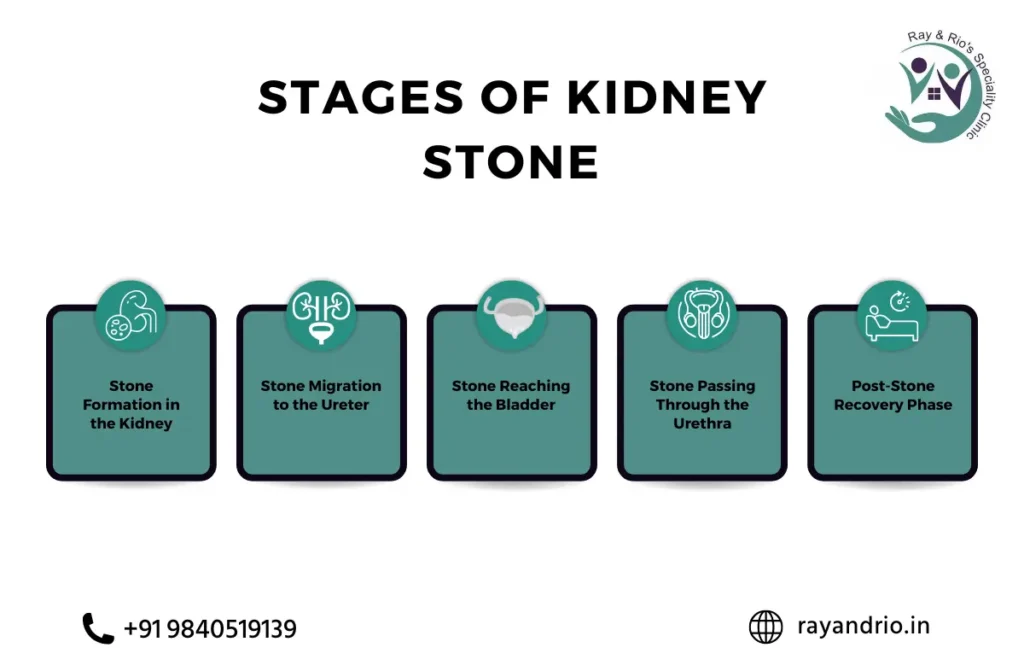Kidney stones are small, hard deposits that form in the kidneys and can be extremely painful to pass. Understanding the stages of passing a kidney stone can help prepare you for what to expect and how to manage the pain. Whether you’re dealing with your first kidney stone or have experienced them before, knowing the process can make things easier.
Understanding Kidney Stones
Kidney stones are hard mineral and salt deposits that form inside your kidneys. They can be as small as a grain of sand or as large as a golf ball. When a kidney stone starts moving, it can cause severe pain, often described as worse than childbirth.
Kidney stones affect millions of people each year. These tiny but painful mineral formations can cause discomfort and disrupt daily life. But by understanding the stages of passing a kidney stone, you can better manage the experience and find ways to relieve pain.

What Are Kidney Stones?
Before we dive into the stages of passing a kidney stone, let’s first understand what they are. Kidney stones form when minerals like calcium, oxalate, and uric acid build up in the kidneys and harden into solid masses.
Common symptoms of kidney stones include:
- Intense pain in the lower back, abdomen, or groin
- Frequent and painful urination
- Blood in the urine
- Nausea and vomiting
Now, let’s go step by step through the stages of passing a kidney stone so you know exactly what to expect.
The Stages of Passing a Kidney Stone
The stages of passing a kidney stone typically follow a predictable process. Let’s break it down.
1. Kidney Stone Forms
Kidney stones start forming when excess minerals and salts clump together in your kidney. This can happen due to dehydration, diet, or genetics. At this stage, you won’t feel any pain because the stone is just sitting in your kidney.
2. Stone Leaves the Kidney
Once the kidney stone starts moving, the pain begins. The stone travels from the kidney into the ureter, the narrow tube connecting the kidney to the bladder. This is often the most painful part because the ureter is very small, and the stone may get stuck.
3. Bladder Pressure Builds
When the kidney stone reaches the bladder, the pain may decrease. However, you’ll start feeling the constant urge to urinate. The stone irritates the bladder, causing discomfort, burning sensations, and frequent bathroom trips.
4. Kidney Stone Exits
Finally, the stone moves from the bladder into the urethra, where it exits your body. You might feel a sharp pain as the stone passes, but relief usually follows immediately. If the stone is small, you might not even notice it leaving.
If you’re wondering how long does kidney stone pain last after passing, it usually fades within a few days. However, some people experience pain months after kidney stone removal if there’s lingering irritation or another stone forming.
What Causes Kidney Stones to Form?
Several factors can lead to kidney stones, including:
- Dehydration: Not drinking enough water causes minerals to concentrate and form stones.
- Diet: High-sodium, high-oxalate, and high-protein diets can increase the risk factors of kindey stone.
- Genetics: If kidney stones run in your family, you may be more prone to getting them.
- Certain medical conditions: Conditions like gout and urinary tract infections can contribute to stone formation.
Identifying Kidney Stones
Signs You Have a Kidney Stone
- Sharp pain in the lower back, abdomen, or groin
- Blood in urine
- Nausea and vomiting
- Frequent urge to urinate
- Burning sensation while urinating
If you experience severe pain that won’t go away, it’s best to see a Kidney Specialist immediately.
How Does Passing a Kidney Stone Feel?
Many people ask, “How do you feel after passing a kidney stone?” The answer varies. Some feel immediate relief, while others experience lingering discomfort. Your urinary tract might be irritated for a few days, leading to mild burning when urinating.
Another common question is, “How long does kidney stone pain last after passing?” Again, it depends. Some people recover in hours, while others feel soreness for days. If pain persists for weeks, consult a doctor.
A less common issue is pain months after kidney stone removal. If you experience ongoing pain long after passing a stone, it could indicate another stone forming, scarring, or a urinary tract infection.
What Helps Kidney Stones at Home?
If you have a small kidney stone, you can try passing it at home using natural remedies. Here are some simple ways to help the process along.
- Stay Hydrated: Drinking plenty of water helps flush the stone out faster. Aim for at least 12 cups of water per day.
- Avoid Irritating Drinks: Caffeinated and carbonated drinks can irritate the bladder, making the pain worse. Stick to water, lemon juice, and herbal teas.
- Adjust Your Diet: Reduce foods high in oxalates (like spinach, nuts, and chocolate) to prevent future stones.
- Stay Active: Mild exercise, like walking, can help move the stone along. Just be careful not to overexert yourself.
If you’ve recently passed a stone and are still experiencing pain months after kidney stone removal, you might need to check for a lingering infection or another stone forming.
Kidney Stone Treatment
If the pain is unbearable or the stone is too large, a doctor may suggest treatment options such as:
- Medication: Certain drugs can help relax the ureter and ease the stone’s passage.
- Shock Wave Therapy (ESWL): High-energy sound waves break the stone into smaller pieces.
- Ureteroscopy: A small camera is used to remove the stone manually.
- Surgery: In rare cases, surgery is required for large or stuck stones.
⏱️ How Long Does It Take to Pass a Kidney Stone?
The duration for passing a kidney stone depends on its size, location, and individual factors. Smaller stones (less than 4mm) may pass within a few days to two weeks, while larger stones can take several weeks or even require medical intervention.
✅ Factors Affecting the Duration:
- Stone Size: Smaller stones pass faster, while larger stones take longer.
- Stone Location: Stones near the bladder exit quickly, whereas those in the ureter may take more time.
- Hydration Levels: Drinking plenty of water (2-3 liters daily) can speed up the process.
- Medical Conditions: Underlying health issues may prolong stone passage.
✅ How Do You Feel After Passing a Kidney Stone?
- Immediate relief from sharp pain
- Fatigue due to the strain on the body
- Possible mild discomfort or burning sensation during urination
- Increased urge to urinate temporarily
If symptoms persist or worsen, consult a healthcare provider immediately.
How to Prevent Kidney Stones?
While anyone can develop kidney stones, you can take steps to lower your risk.
Tips to Prevent Kidney Stones
✅ Drink plenty of water (at least 2 liters daily)
✅ Eat a balanced diet with less salt and processed foods
✅ Reduce oxalate-rich foods if you’re prone to stones
✅ Maintain a healthy weight
✅ Get regular check-ups if you have a history of stones
If you’ve experienced pain months after kidney stone removal, it could mean another stone is forming. Staying proactive with prevention is key.

Conclusion
The stages of passing a kidney stone can be incredibly painful, but understanding them can make the process more manageable. By staying hydrated, making smart dietary choices, and seeking medical help when necessary, you can get through it with less discomfort.If you’re dealing with kidney stone pain and need professional help, don’t hesitate to reach out. Contact us today for expert advice, personalized treatment plans, and prevention strategies to keep kidney stones from coming back.
Read Also : Exercise for Kidney Stones
